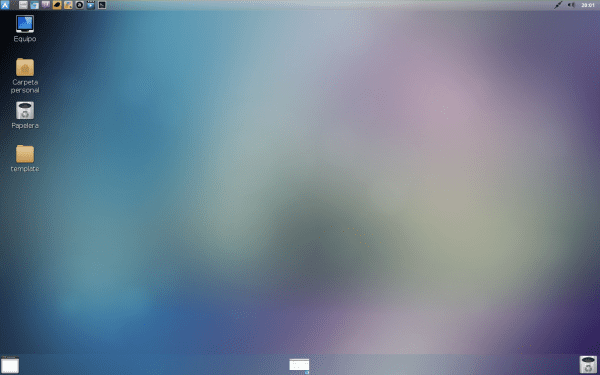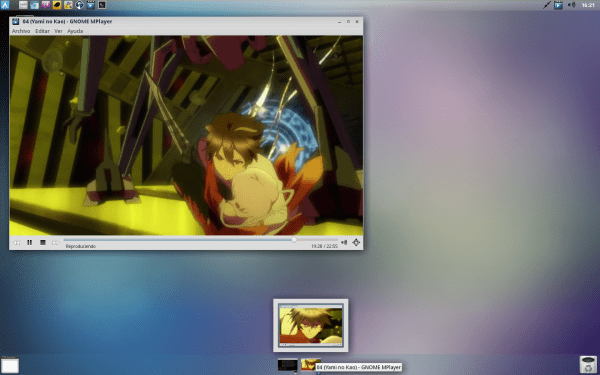Since a good part of the blog articles are intended for Xfce, KDE, and one that another occasional criticism of Gnome, I wanted to give his place to LXDE. We know that by default LXDE it is not as complete as, e.g., Xfce. Sometimes you even have to resort to parts of other desks to leave it at ease. Today I bring you several Tips that will allow you to have a LXDE more at ease 😉
Before we start, I assume you already have at least the distro ready (if they are going to start from scratch ...). That is, they already have Xorg, session manager (if they use) Y LXDE installed. For LXDE it is recommended LXDM as a session manager, although I like it better LightDM.
In case you have not yet installed the distro, or the desktop, it would be convenient to leave some here:
- Archlinux: base installation (DesdeLinux) (Gespadas), LXDE installation (DesdeLinux) (Gespadas).
- Debian: base installation (Taringa), LXDE installation (Wiki).
Those are Two examples that I can give. I don't rewrite them by hand because they are already there, you just need to link them. In my case, I did it in Archlinux, and I used the 4 guides, comparing them and adding in one what was missing in another. I recommend that.
I also noticed that Elav had made a mini guide before, I will include some things here since you have to give it some merit 😉
Good. Let us begin.
LXMED, a menu editor for LXDE
First thing's first. This will be needed for some parts of this tutorial. LX Menu Editor was designed with the aim of providing LXDE un Menu editor simple, but effective. And in fact, Not only It works with LXDE, also I have successfully tested it with Xfce : )
The only thing that requires LXMED to work is Java (OpenJDK / Oracle whatever works) and, depending on the distro, gksu / beesu / etc ...
We download it here. Then, we unzip it, we enter the folder, and in a terminal we do:
sudo ./install.sh
And it will have been installed. We will find it in the menu LXDE under the category «Preferences«, Although curiously there will be the Name in english. Do you think the same as me? We will edit the menu entry, of the menu editor, with the menu editor itself: Menu-Inception 😛
We open LXMED and it will ask us for the root password. We introduce it, click on «Accept" and ready. Let's go to the category «Preferences»And click on«Menu Editor", Then in "Edit«. In name, then place what you want. I wrote "Edit the main menu«.
Desktop shortcuts
Whoever has used other desks like Xfce, you may have noticed that from the beginning there are a few Shortcuts for Personal folder, Trash, etc.
LXDE I used to bring one for the Personal folder, it was called My Documents (Windows Detected? XD), but it is gone. So, we will modify algunos pitchers to get a similar result.
We open the menu of LXDE, and we look for the File Manager »Right Click» Add to Desktop. In total, we will do that about 3 times. The following is to open each one of them with a text editor and modify the parts indicated below:
For the computer icon:
Icon=computer
Name=Equipo (o como prefieran).
Name[es]=Igual que en Name.
Exec=pcmanfm computer:///
For the Personal Folder icon:
Icon=user-home
Name=Carpeta Personal (o como prefieran).
Name[es]=Igual que en Name.
Exec=pcmanfm ~
For the trash can icon:
Icon=empytrash.png
Name=Papelera (o como prefieran).
Name[es]=Igual que en Name.
Exec=pcmanfm trash:///
With that we should already have the three basic icons on the desktop 🙂 With those same steps you can create other shortcuts.
Edit LXDE keyboard shortcuts
LXDE it doesn't come by default with a tool like this. But since LXDE uses Openbox, we can use obkey 🙂 To install it on Debian it would be:
sudo apt-get install obkey
And for Arch:
sudo pacman -S obkey
By default Obkey opens the file open box who is in ~ / config / openbox / rc.xml. But, if we launch it this way:
obkey ~/.config/openbox/lxde-rc.xml
So if you open the file LXDE. Now, let's say we want pressing the key [Print] run scrotum to take a screenshot… We execute the previous command, click on the second top bar icon (the one to add). In the section Actions, we select «Run«, And at the top, where it says«command»We write, for example:
scrot '%Y-%m-%d-%H:%M:%S_$wx$h.png' -e 'mv $f /home/usuario/Capturas/'
I must not say that «user»Is your username or yes? That would create a screenshot with time and date, and I would keep it in the folder "Catches" from your Home. Finally, click on the keyboard shortcut in the list, and press the key [Print]. We save, and voila! A new keyboard shortcut.
Add important shortcuts to the LXDE menu
Since i knew that LXMED let me modify the menu, I ran to create some shortcuts to modify common LXDE options Instantly.
The one that says «LXDE autostart»Is a shortcut to modify applications or processes that are started with LXDE.
«LightDM GTK Greeter»Is to modify the GTK appearance of LightDM.
I also created one in the accessories section, called «File manager (root)" That opens PCManFM as root.
Coincidentally, there is also one that opens Obkey pointing to the LXDE file 🙂 It's called «Edit LXDE keyboard shortcuts«.
Replace LXPanel with LXPanelX
The truth, to the panel LXDE it's missing some features that would make it more customizable / useful, so… why don't we change it? Some time ago a LXDE panel fork, LLAMADA LXPanelX. Maybe it's a little heavier than the LXPanel traditional, but if they are willing to spend a little more RAM do not hesitate to try it 🙂
First of all, we must make a change in the file LXDE autostart. So as root, using our favorite editor, we will open it. For example:
sudo leafpad /etc/xdg/lxsession/LXDE/autostart
Inside it, we will see a line that says:
@lxpanel --profile LXDE
We will simply change it like this:
@lxpanelx --profile LXDE
And ready. Now, to apply the change immediately, and start configuring LXPanelX at will, just open a terminal, and do:
killall lxpanel && lxpanelx --profile LXDE
That will be enough. Or just restart the PC xD
There is also a certain detail. The launcher of LXPanelX it won't open when you press [Alt] + [F2], because it comes by default to open the de LXPanel (yes, the command is different). So with obkey, we will open the file LXDE and we will look for the part where the shortcut of [Alt] + [F2], and we will edit your command. We will leave it like this:
lxpanelxctl run
Now the application launcher will open.
Replace PCManFM with SpaceFM
Already once there was talk of SpaceFM hereIs a PCManFM fork, Also called PCManFM-Mod, and it is nothing more and nothing less than a PCManFM with even more functions, and practically the same consumption. Personally, I still use PCManFM, I don't need so many options. But if you want use SpaceFM by default, I teach them.
We will edit the file LXDE autostart. There is a line that goes like this:
@pcmanfm --desktop --profile LXDE
We will change it to look like this:
@spacefm --desktop --profile LXDE
With that SpaceFM will manage the desktop instead of PCManFM. In this respect they are both identical, so I don't use it 😛 Although the fonts look a little better with SpaceFM I would say. Now, for the change to be immediate, we execute in the launcher LXDE:
killall pcmanfm && spacefm --desktop --profile LXDE
With that it will be ready 🙂
Configure Openbox from LXAppearance
Default LXAppearance it only takes care of the theme GTK, icons, source y cursor. But we can save ourselves having to open ObConf, installing the package lxappearance-obconf, which should be present in most (if not all) distributions.
Recommended layouts with LXDE
To finish, I leave you a small list of distros that I have tried with LXDE and that I think are worth it.
- Mini Trisquel. Based on Ubuntu. It only has free packages, and an LXDE similar to Lubuntu but simpler. Maxwell analysis, available Trisquel 5.5 STS Brigantia, Official Site.
- PC Linux OS LXDE (Mini, what was the iso that went down). A nice custom LXDE, although somewhat loaded for my taste. It comes with a multitude of drivers by default. It uses RPM packages, but manages them with APT. Pandev92 analysis, Official Site.
- PINK Linux Marathon 2012 LXDE. A simple, semi-personalized and very complete LXDE, as well as beautiful. It's LTS, and it's a fork of Mandriva. Released ROSA Linux Marathon 2012, Official Site (LXDE community version page).
- Lubuntu. An official Ubuntu derivative (adopted by Canonical as of version 12.04 LTS) with LXDE. Recommended, low consumption (about 80MB), good artwork, with light applications and others. Official Website.
- Fedora Spin LXDE. This is another one that I recommend. Lightweight, with a very good package manager, LXDE's default appearance (but can still be customized). Spin LXDE official page.
Those are distros ootf (Out of the Box, or ready to use). There are also other options, like Debian, Arch, Gentoo, Mageia 2, Slackware… Which are minimal, and more suitable for some. Of those I would stay more with Debian and Arch 😉
And well, that was my guide to LXDE. You know, this guide can keep growing ... Oh, idea! If they have cheats for LXDE, leave them in the comments, and I will gladly add them to the guide. Cheers! 😀







Interesting truth but the Lxpanelx how much more memory would spend 10 50 or 200 mb more?
The truth is it looks luxury but you would have to see as much or how little the ram rises if they are from 10 to 50 megabytes it would be luxury.
You don't have to be an extremist, about 25 MB of RAM more or less, as I recall ...
That's great note that the icon theme is or looks like linuxmint especially on the top bar.
Thank you very much AurosZx, with this maybe I encourage myself to install arch + lxde 😛
Thanks for these excellent Tips to improve LXDE and I'll try them los
I had to reread the article. the desktop looks spectacular. I even thought it was KDE! 🙂
Hehe, is that LXPanelX works wonders… Thanks 😉
in fact I have to honestly say, it's the most extraordinary LXDE desktop I've ever seen! I didn't know I had those possibilities.
if it is very customizable, only a global menu is missing
Another distro that I loved was Linux Mint (I think it was 11) with LXDE. It was spectacular, I preferred it to Lubuntu because the latter leaves some transparent spaces next to the clock ...
I did not know LxpanelX and it looks luxurious !!
Greetings and congratulations on the article!
That was the last good edition of mint, the 11 with LXDE, the 13 (maya) is not bad at all
Hmm, Mint LXDE… I haven't tried it, maybe I should.
Thanks, with all these tips it is worth installing LXDE
Stamina Lubuntu !!
Excellent Tips, invite you to try LXDE, on the net very little is said about this desktop environment. Thanks for the input.
I know, even here not much is mentioned 😉 I knew I had to make a guide of these yes or yes.
Your desktop looks great.
Thanks 😉 Fedora LXDE is another good one, I forgot to add it ...
Didn't know about lxappearance-obconf. It was rotten to open both. Very good tip!
Excellent guide, I was on Lubuntu for a while, but I have never felt comfortable outside of XFCE.
As a data, I believe that Lubuntu is already an official derivative.
Excellent article.
I've been looking for a good lxde distro… I currently have Fedora 17 spin lxde and I recommend it…. but you made me curious about Rosa's lx distribution… can you give me more details about it?
Well, I just tried it for a while, but I can say this: it has a nice appearance (and the home screen is great too), its consumption is not that high (about 100MB I think), the graphical package manager is very easy to use (It's called RPM Drake, and yes, ROSA uses RPM packages because it's based on Madriva), it comes with several codecs (well no, it comes with Deadbeef and VLC that have certain codecs: D). That was what I noticed at first glance. I would say that you just need to install Compton to make it perfect, because it already comes with LXPanelX 🙂
Some time ago I was testing lxde, it can be used with compiz without problems, it would be nice if you add it in the tutorial. you can also use the unity-2d panel, in case you like the global menu 😛
Guillo and how did you do it? what to install the global menu in lxde ?, is it only to install the unity-2d-panel package or do you have to do something else ???
I'm glad for the publication of this article, because it helps my favorite desktop environment, LXDE, to have more presence, since it is clear that it is very customizable and that it has nothing to envy to other desktops. What's more, others can envy LXDE something that no other has (perhaps E17): its extreme lightness.
Greetings.
PS: 'obkey' is not in the Debian repositories.
Great tutorial and everything very well explained, congratulations. But I have a question, how can I install lxpanelx ?, since in the link you provide is only the project repository. In case it changes at all, I am using Lubuntu.
Thank you very much.
Greetings.
Oh well I found a .deb for Lubuntu, which runs fine on Debian and the like. You can download it from this repo https://launchpad.net/~daniel-go-mon/+archive/maloy-lubuntu
Since this post lacks the opinion of Courage, I liked to read his comments that were always contrary to others. I feel that that Spaniard is needed, although if I went to Spain and found him in a better hospital, I would run out of it and go to another.
Very good post, I made a very humble program: p for icons, in java, although I remember there is an editor that no longer adds it to LXDE in the programs menu: p
http://kyo3556.wordpress.com/2011/12/03/creador-de-iconos-para-lubuntu/
Thanks for the tips! On Monday I planned to test it on debian. What do you recommend for managing Wi-Fi networks? Network-manager, wi-cd, or something different?
I have tried both, and I really liked NetworkManager more, of course, with the gnome frontend. I feel more complete. Now, if you only use wired and wireless networks, you can use Wicd and that's it 🙂
Haha I don't look like you ...
And now how do I uninstall LXMED?
I would like to place the Places submenu within the Menu. Could someone tell me if it can?
I want to install Globalmenu where I can start. Some tutorial.
How can I have a desk like yours? As well as in the images.
Thank you, gentleman!
Something as silly as putting pcmanfm before entering the address of a folder has solved a real headache that I had. I just installed LXDE on my Ubuntu to make it better for me and it was by no means getting me any location. All I found were forum threads abandoned decades ago with solutions or threats of solutions that did not help me.
With this, I can finish customizing my desktop completely to my liking. The truth is that I am really liking LXDE.